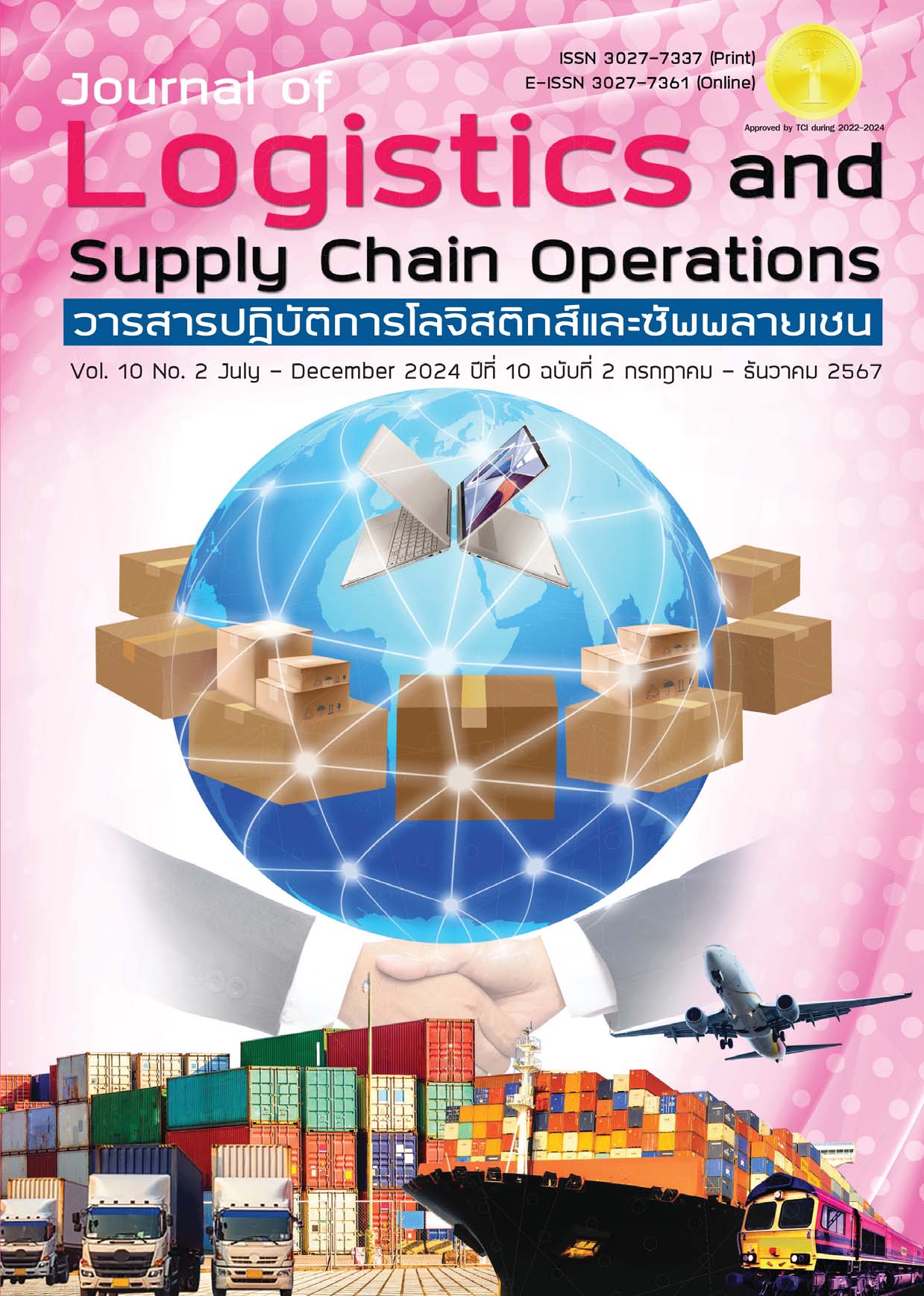A Selection of Suitable Digital Platforms for Direct Marketing of Tubtim-Chan Rose Apple Farmers in Thailand Using the Fuzzy Analytic Hierarchy Process
DOI:
https://doi.org/10.53848/jlsco.v10i2.266815Keywords:
Digital Marketing Platforms, Fuzzy Analytic Hierarchy Process, Online Marketing, Tubtim-Chan Rose Apple, Marketing StrategyAbstract
Agriculture sector of Thailand has been facing changing economy and production structures issue causing agriculture sector’s GDP hardly increased in the past 9 years (2012-2021),leading to Thai government proposing the Smart Farmer policy to aid those farmers. Hence, to be a part of solving the issues and in line with the government’s policy, this research aims to firstly evaluate and select the suitable marketing digital platforms and secondly present the effective implementation measures of selected platforms for Tubtim-Chan Rose Apple farmers group in Nakorn Pathom, Thailand. The research used a mixed method between qualitative and quantitative research by surveying, interviewing, and Fuzzy analytic hierarchy process (FAHP) assessment. The research population is 591 households of Tubtim-Chan Rose Apple farmers group and related stakeholders in Nakorn Pathom province area. The research uses purposive sampling to select 20 participants who pass the exam according to basics understanding of digital marketing, from 95 participants. The results reveal that the suitable platforms assessment for digital marketing strategy of the farmers group, the assessment scores calculation for each digital marketing platform shows that the best digital platform is social media (0.327), the second rank is email (0.264), websites (0.173), online shopping (0.139), and search engines (0.096), respectively. For implementation of selected digital platform, the researcher recommends initially the farmers group should begin with the Facebook fan page integrating with email marketing strategy since these two platforms easy to use and their relevant costs less than other platforms.
References
กรมส่งเสริมการเกษตร. (2560). ระบบสารสนเทศการผลิตทางด้านเกษตรออนไลน์. ค้นเมื่อ 6 สิงหาคม 2565,จาก: http://nonghan.udonthani.doae.go.th/010855.htm
ณัฐพร สว่างวงศ์สิน. (2555). การประยุกต์ใช้กระบวนการ AHP ในการประเมินผู้ขาย: กรณีศึกษาธุรกิจค้าปลีกสินค้ากลุ่มห้องนํ้า. วิทยานิพนธ์ปริญญามหาบัณฑิต สาขาบริหารธุรกิจ, มหาวิทยาลัยธุรกิจบัณฑิต.
ทวีศักดิ์ ธนเดโชพล, วิภพ ทีมสุวรรณ และอุทัยวุฒิ ชํานาญแก้ว. (2561). ปฏิรูปเกษตรในไทย. การประชุมวิชาการด้านการชลประทานและการระบายนํ้าแห่งชาติ ครั้งที่ 11, 292-303.
นิพนธ์ พัวพงศกร และกัมพล ปั้นตะกั่ว. (2566). การตั้งหลักใหม่ภาคเกษตรในอนาคต. กรุงเทพฯ: สํานักงานพัฒนาการวิจัยการเกษตร (องค์การมหาชน).
ปฐมพงศ์ สุธารักษ์. (2555). ปัจจัยที่มีผลต่อการเลือกซื้อชมพู่พันธุ์ทับทิมจันท์ที่ปลูกในจังหวัดสิงห์บุรี. การค้นคว้าอิสระปริญญามหาบัณฑิต สาขาวิชาธุรกิจเกษตร, มหาวิทยาลัยเชียงใหม่.
รัฐการ บัวศรี และอิสริยณี ฤทธิมาศ. (2564). แนวทางส่งเสริมการตลาดออนไลน์ของวิสาหกิจชุมชนเกษตรกรอินทรีย์ภาคตะวันออกเฉียงเหนือ. วารสารการบริหารการศึกษา มมร. วิทยาเขตร้อยเอ็ด, 1(3), 22-32.
ศราวุธ ไชยธงรัตน์ และณัฐพัชร์ อารีรัชกุลกานต์. (2564). การประยุกต์ใช์กระบวนการวิเคราะห์เชิงลําดับชั้นในการคัดเลือกผู้ขายอย่างยั่งยืนกรณีศึกษาบริษัทเอบีซี. วารสารวิทยาลัยโลจิสติกส์และซัพพลายเชน,7(2), 5-17.
สมพงษ์ เหมบุตร. (2560). การศึกษาเกณฑ์การคัดเลือกผู้ผลิตชิ้นส่วนที่ยั่งยืนของผู้ผลิตฮาร์ดดิสก์ตามแนวทาง Triple bottom line (TBL). วิทยานิพนธ์ปริญญามหาบัณฑิต สาขาวิศวกรรมอุตสาหการ, มหาวิทยาลัยธรรมศาสตร์.
เสริมศิริ นิลดํา, กรกนก นิลดํา, กฤษณะ แสงจันทร์, อภิสรา กฤตวาณิชย์ และสาวิตรี พรหมสิทธิ์, (2563).การพัฒนาศักยภาพการสื่อสารการตลาดแบบบูรณาการผ่านสื่อดิจิทัลของเกษตรกรผู้ปลูกสับปะรดนางแล. วารสารวิทยาการจัดการ มหาวิทยาลัยราชภัฏเชียงราย, 15(1), 217-238.
สุรชัย ศรีนวลจันทร์ และบุหงา ชัยสุวรรณ. (2562). กระบวนการสร้างตราสินค้าและการสื่อสารการตลาดออนไลน์สินค้าเกษตรอินทรีย์. วารสารวิชาการเกษตร, 37(2), 177-185.
Bansod, S., & Kubde, R. (2012). The analytic hierarchy process based supplier selection approach for collaborative planning forecasting and replenishment systems.International Journal of Engineering Research & Technology, 1(7), 1-12.
Chang, D. Y. (1996). Applications of the extent analysis method on fuzzy AHP. European Journal of Operational Research, 95(3), 649–655.
Charlesworth, A. (2018). Digital marketing: A practical approach. 3rd ed. London. Routledge.
Cheng, C.-H., Yang, K.-L., & Hwang, C.-L. (1999) Evaluating attack helicopter by AHP based on linguistic variable weight. European Journal of Operational Research, 116(2),423-435.
Jitrawichawet, S., Sarfaraz, A., & Jenab, K. (2013). Reliability-based foreign supplier selection using fuzzy-AHP. International Journal of Applied Decision Sciences, 6(3), 245-262.
Kahraman, C. (Ed.). (2008). Fuzzy multi-criteria decision making: Theory and applications with recent developments (Vol. 16). Springer. https://link.springer.com/book/10.1007/978- 0-387-76813-7
Li, C., Solangi, Y. A., & Ali, S. (2023). Evaluating the factors of green finance to achieve carbon peak and carbon neutrality targets in China: A delphi and fuzzy AHP approach.Sustainability, 15(3), 2721.
Liu, Y., Eckert, C. M., & Earl, C. (2020). A review of fuzzy AHP methods for decision-making with subjective judgements. Expert Systems with Applications, 161, 113738.
Maity, B., Mallick, S. K., Das, P., & Rudra, S. (2022). Comparative analysis of groundwater potentiality zone using fuzzy AHP, frequency ratio and Bayesian weights of evidence methods. Applied Water Science, 12(4), 63.
Ocampo, L., Besabella, O., Fallore, M., Guinandal, A. R., Merabueno, A., Himang, C. M., &Yamagishi, K. (2021). An integrated AHP-TOPSIS for evaluating online marketing strategies for the hospitality industry. International Journal of Asian Business and Information Management, 12(3), 1-28.
Piya, S., Shamsuzzoha, A., Azizuddin, M., Al-Hinai, N., & Erdebilli, B. (2022). Integrated fuzzy AHP-TOPSIS method to analyze green management practice in hospitality industry in the sultanate of Oman. Sustainability, 14(3), 1118.
Rangaswamy, A., Moch, N., Felten, C., van Bruggen, G., Wieringa, J. E., & Wirtz, J. (2020).The role of marketing in digital business platforms. Journal of Interactive Marketing, 51(1), 72-90.
Ruoning, X., & Xiaoyan, Z. (1992). Extensions of the analytic hierarchy process in fuzzy environment. Fuzzy sets and Systems, 52(3), 251-257.
Saaty, T. L. (1980). The analytic hierarchy process: Planning, priority setting, resource allocation. New York: McGraw-Hill.
Şengül, Ü., & Eren, M. (2016). Selection of digital marketing tools using fuzzy AHP-fuzzy TOPSIS. In A. Kumar & M. Dash (Eds.), Fuzzy Optimization and Multi-Criteria Decision Making in Digital Marketing (pp. 97-126). IGI Global. https://doi.org/10.4018/978-1-4666-8808- 7.ch005
Singh, V., Kumar, V., & Singh, V. B. (2023). A hybrid novel fuzzy AHP-TOPSIS technique for selecting parameter-influencing testing in software development. Decision Analytics Journal, 6, 100159.
van Laarhoven, P. J. M., & Pedrycz, W. (1983). A fuzzy extension of Saaty’s priority theory. Fuzzy Sets and Systems, 11(1), 229-241.
Wang, Y. M., Luo, Y., & Hua, Z. (2008). On the extent analysis method for fuzzy AHP and its applications. European Journal of Operational Research, 186(2), 735-747



